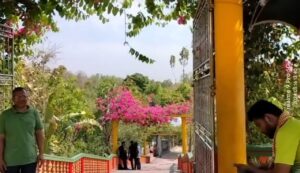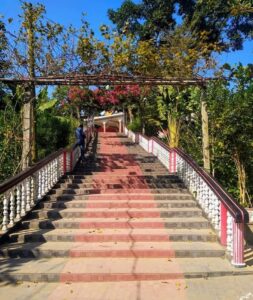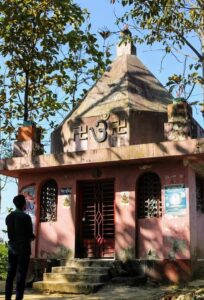About 55 acres of land of Sri Sri Chandithirtha & Medosh Munir Ashram were occupied by some influential people at Karadengha hill in Boalkhali upazilla under Chittagong district in Bangladesh
 Sangram Datta
Sangram Datta
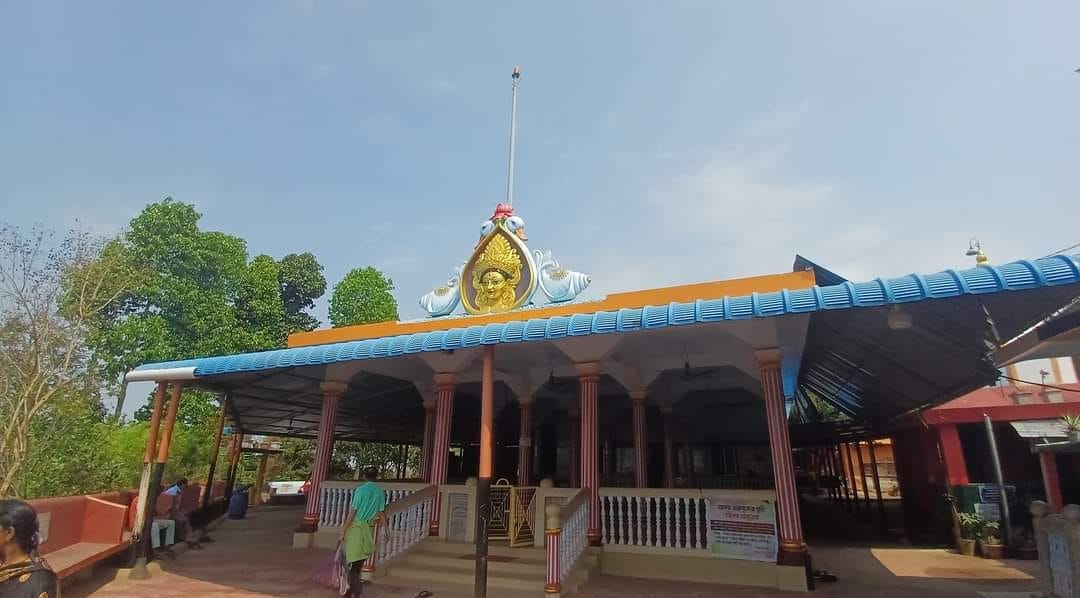
This temple is situated in the picturesque surroundings of the hills about 500 feet above from the ground.It is blessed with natural beauty. It’s unique for the age-old history that it owns; it is unique because it allows pilgrims and visitors the scope to find inner peace in a place that is surrounded by natural beauty and tucked away from intrusive industrial development.
It’s most important that the Sanatan people in Bangladesh revere this place because of the legend that claims the area of Sri Sri Chandi Dham & Medosh Ashram is to be the origin of Bashanti Puja, the celebration of Durga Puja during spring.
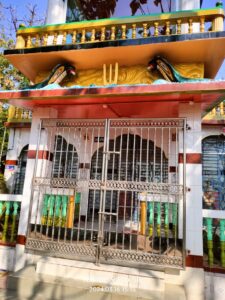
The legend in Kalika Puran and Kamakhkha Puran states that back in the age of truth (Satya Yuga), King Surath performed the first ever Durga Puja in spring after getting instructions from Sage Medha
King Surath, after being defeated and losing his kingdom, decided to leave everything behind and went to the deep forest where he met Samadhi Vaishya who also took solace in the same forest after being ousted and betrayed by his family. As they were wandering in the forest, they met Medosh Muni, a sage meditating there. They went to him and asked him for the reasons behind their sufferings.
“Mahamaya (the illusion),” came the answer from Medha Muni, who also suggested that if they could get rid of this illusion and satisfy ma Durga, the deity they would get Mahamukti and their sufferings would come to an end.
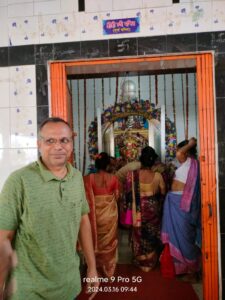
Sitting in that very forest with two very confused souls, Medha Muni gave a series of advice, known as Sri Sri Chondi. On his suggestion, King Surath and Samadhi Vaishya performed the Bashanti Puja and got back peace in their life. This launched the ritual of performing Bashanti Puja in spring or Chaitra.
“Lord Rama is believed to have performed ‘Akalbodhan’ (‘Akal’ meaning untimely and ‘Bodhan’ meaning awakening) to seek Goddess Durga’s blessings for defeating Ravana”.
“Since then, Lord Rama’s devotees started celebrating Durga Puja in Sharat or autumn. As a result, Bashanti Puja almost disappeared into oblivion, but it is still performed in a few Bengali households while observing all the rituals of Durga Puja.”
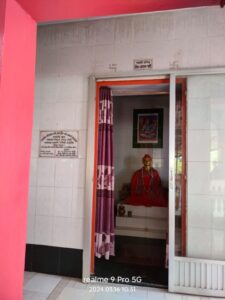
The difference between the two Durga Pujas – Bashanti Puja and Sharadiya Durga Puja – lies in their origin story and time of celebration; the rituals remain almost the same.
During late 1900, Srimat Vedananda Swami, after years and years of meditation, received the spiritual message that on top of the Karaldenga Hills in the forest, Medha Muni meditated and suggested king Surath to offer a puja for deity Durga for the very first time. After the rediscovery of the ashram, Medhashmunir Ashram is considered to be one of the most important pilgrimage sites for devotees.
Mahendra Ghoshal and Neel Krishna Roy, owners of the land adjacent to the ashram, donated more than 68 acres of land and hills in the name of Dashabhuja Devi.
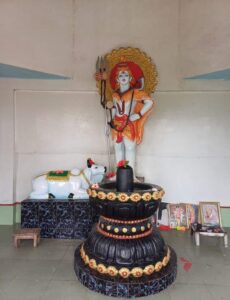
Goddess worship was begun by constructing a house on the top of the hill with thatch, bamboo and tin. The first priest was appointed ‘Gauri Shankar Smrititirth’ of Kanungopara village, it’s learnt.
In 1920 A.D, Maharaja Manindra Chandra Nandi of Kashim Bazar under the then Murshidabad district of united Bengal built Sri Sri Chondi Mata Mandir at this shrine. Later, A complete brass Durga Murti ( Statue ) was established by the courtesy of Jugendra Nath Bhattacharya, the highest police officer of Brahmadesh (Now Myanmar).
On 5 April 1971, The Ashram was once again demolished when during the Liberation War of Bangladesh, the Pakistani military used gun powder, turned the entire place into piles of ashes, destroyed the six-feet tall deity and looted valuable things.
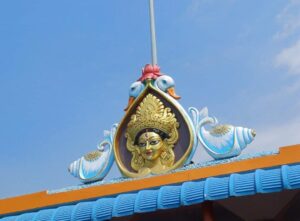
Right after Bangladesh’s independence, there was no one to take care of this sacred ashram. With time and dedication of a newly formed Ashram committee, consisting of devotees, sadhus and pandits of the city, the ashram has once again regained its past grandeur.
In 1987, A stone idol of the ten-armed goddess Durga, hand-made by artist Prafulla Kumar Acharya of Howla village was established in Howla village under the guidance of Haripad Kanungo, a social worker of Kanungo Para village. The annual worship of this goddess idol is performed continuously every day.
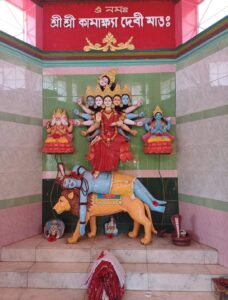
A Ganesh temple is found at the entrance to the ashram. Marvelous main temple is situated about 500 feet up of the hill. About 140 stairs are seen at Medhas Muni Ashram.
Sree Sree Chandi temple is in the main ashram. Samadhi Temple of Yugi Purusha Swami Vedananda Maharaj, the founder of the ashram is adjacent to the Chandi Temple.
To the right of the main ashram, the Kamakshya temple is situated a little further along the hilly path. Then there is a Shiva temple on the top of the highest hill. After going down a few more stairs of that hill, devotees have to climb again to the top of another hill. The Tara Kali temple is at the top of that hill.
Medhasswari Dakshina Kali temple is n a hill to the left of the main ashram . Temples of Kamakshya , Shiva and Tara Kali are at the junction of the hill Manas Sarovar. There’s a lake is about 300 feet below of the main ashram. The mountain stream is constantly flowing in this lake. The Sita temple Next to it. Legend has it that Sita bathed in this lake during Treta Yuga.
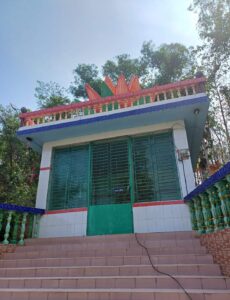
The Bhog house, Ashram Principal’s office, Yatri Niwas are at the near of the main Chandi temple.
There are 12 tortoises of extinct species at the base of the jackfruit tree in front of this restaurant. They are known as sage turtles. This extinct species of tortoise lives by eating flowers, leaves and fruit peels. It is said that a sage was turned into a tortoise by the curse of sage Medhas. The ashram has two cows and a deer cub under its care.
About 30 people are working in the temple, said Swarup Chowdhury, who is in charge of the temple.
Shreemath Bulbulananda, Maharaj of the Sri Sri Chandi Tirtha & Medhas Muni Ashram has this ashram had 68.19 acres of land as a deity’s property. But despite the court’s injunction, some local influential quarters grabbed about 55 acres of land of the ashram, Maharaj Bulbulanand alleged.
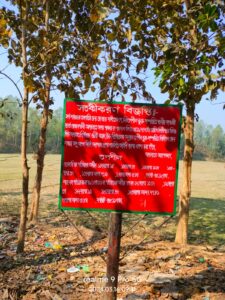
Nothing really keeps one away from enjoying the serenity and natural beauty that this place offers. Once devotees who climb the stairs, will find a different universe up there. As soon as devotees get into the Ashram’s territory, pilgrims will suddenly discover themselves surrounded by nature – by trees and flowers, by birds and reptiles, by hills and meadows.
Up there everything is silent, except for the chirping of birds and reptiles revving up in their homes, along with devotional chants and tinkling sounds of the brass bells used during Puja. While climbing the stairs, all devotees can see is a riot of greenery, the pinwheel patterned night-flowering jasmines, or as people lovingly call it Shiuly on, beneath devotees feet, signalling the arrival of Durga Puja.
This area is also home to around lacs of trees, including mahogany, rain tree, bamboo, mango and many more, that the Ashram people have nurtured for long time. They also cultivate honey and use it for different rituals in the temples. “For this huge plantation scheme, the ashram recently received a tree plantation award from the Bangladesh government,” it’s learnt.
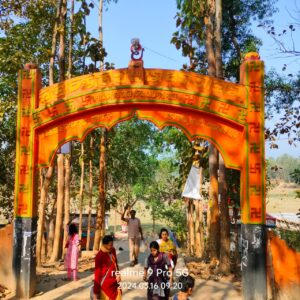
Upon arriving at the peak, pilgrims will find a total of seven temples, standing tall. While pilgrims will find some devotees sitting in a corner humming kirtans and preparing to feed the devotees (annaprasad), others will be busy making garlands and helping the Maharaja of the temple to prepare for the Puja. In the back courtyard, pills will find people tying knots on trees, while some might be feeding a group of turtles. In fact, it will take a whole day to walk around the whole area.
“During the time of Durga puja, thousands of devotees gather here. As this place is the origin of Bashanti Puja, it attracts the most number of devotees every year. At present, lacs of devotees visiting the Ashram every year, but if proper roads are built and if the place receives proper publicity, this number could accelerate.
The temple is mostly run by the funds given by devotees. Previously, there were no stairways and climbing the temples was an arduous task”. All these tiles-fitted, 11 feet wide stairs. One of the devotees constructed this.
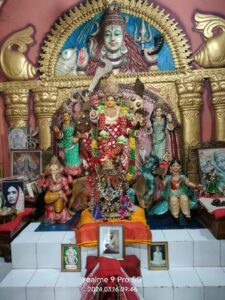
Most of the temples here, Nat Mandir, Kamakhya Mandir, Sib Mandir are the result of the generosity and belief of the devotees.
After independence, Various temples were built with the donations and financial support of numerous devotees and rich people from home and abroad. After all, Each installation was made by the financial aid of the devotees.The beauty of the temple has been enhanced.
This place could be promoted as one of the significant areas of religious tourism in Bangladesh, Sanatan devotees from all over the world could also visit this ashram.
